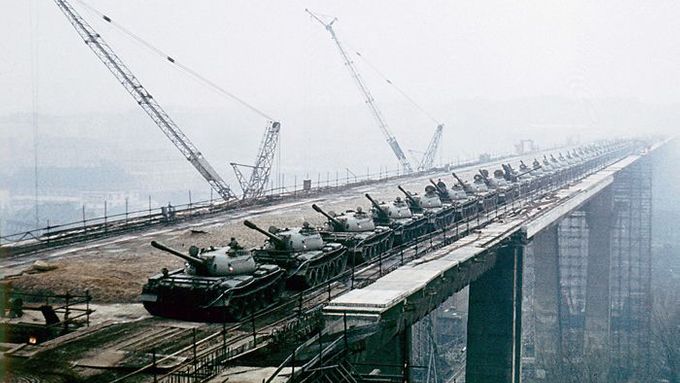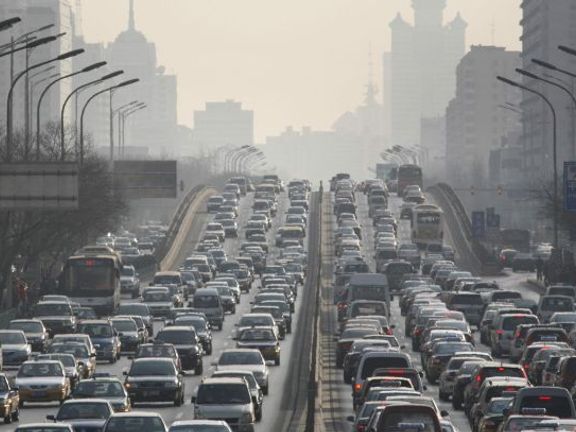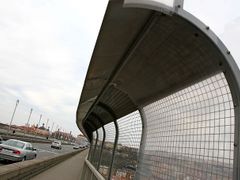Prague - A symbol of the Soviet geopolitical dominance, clever solution to address problems of a rapidly growing capital, or a place notoriously known for attracting suicide jumpers?
Prague's Nusle bridge is all of that and perhaps a bit more.
Above all, the bridge is a major traffic artery of Prague being crossed by 160,000 cars every day. In rush hours the so called magistrála gets easily congested. Even a small road accident can stop the whole traffic. And yet, without the bridge thousands of Praguers would not get to work and back home or just out of town.
Infamous history
It was 35 years ago in 1973, when the Secretary General of the then Communist Party of Czechoslovakia Gustáv Husák cut the red tape and thus opened a new bridge spanning over Prague´s quarter Nusle.
Despite its name after the first Czechoslovak "workers´" president Klement Gottwald, the bridge´s origin clearly shows that real power in Czechoslovakia was held by the Soviets.
Initially, the Nusle bridge constructors designed the bridge for trams. Later, they changed their mind in favor of a home-made subway.
Eventually, however, it was the Soviet "comrades" in Kremlin who decided the bridge would have the Soviet Union-made trains.
READ MORE ABOUT FEBRUARY 1948:
February 1948 - not bloody enough for Moscow
Trial tests with tanks
But the subway trains made by Russians proved to be much heavier than trams or subway wagons produced in Czechoslovakia. The bridge wasn't simply designed for heavy machinery of the Soviet type.
Therefore it was necessary to alter the bridge by putting in a special strengthening frame that distributed equally the pressure throughout the entire bridge.
In 1970, 66 tanks were sent across the bridge to put the load capacity of the bridge to test. Another key weight trial test was performed in 1974 before the underground was launched into operation.
Eventually, lighter types of metro wagons had to be introduced.
Residential bridge pillars?
Although the construction works were initiated in 1967, the project is much older than that.
The idea of bridging the Nusle Valley and joining Pankrác and Karlov first emerged at the turn of the 20th century.
A public competition was held in the interwar period. Interestingly, renowned architect Jan Kotěra, trained in the Vienna Secession artistic group, submitted a plan to build houses inside the pillars. The plan was not accepted.
Finally, the project was initiated in the 1960s. At that time, new residential areas built in Pankrác made the issue of connecting the peripheral parts of the city with the center really pressing.
Socialist construction, capitalist maintenance
It took six years to construct the bridge and, as usual in these times, it was opened on a historically important day - the 25th anniversary of the Communists' coup d'état, or the so-called "Victorious February" of 1948.
In line with the communist idealogy, the building was named after the first communist president of Czechoslovakia Klement Gottwald.
"The opening celebration turned into a major political demonstration of the Communist Party," explained Pavel Fojtík from the Archive Department of the Prague Public City Transport company.
The bridge repeatedly served the communists´ propaganda, being praised as a triumph of socialism that the previous capitalist regime could have never achieved.
However, the bridge surface had to be changed only eight years after it was opened. Ironically, the job was done by a West German company Strabag.
The bridge was temporarily closed for repairs and for key events like the Critical Mass Ride on the occasion of the International Car Free Day on 22 September last year when thousands of bikers could enjoy the peaceful view of the Nusle Valley, or during the World bank and IMF meeting in 2000.
Symbol of personal tragedies
After the Velvet Revolution 1989, the bridge was re-named, called simply after the Nusle quarter - Nusle bridge.
Despite the infamous communist past, the bridge designed by architects Vojtěch Michálek and Stanislav Hubička, won the title of "the building of the century" in the category of transport constructions in 2000.
The Nusle bridge has earned a sad reputation, as it is a place where more than 300 people have voluntarily ended their lives. To prevent people from jumping off the bridge, a high rail was put up along the sidewalks in 1997.
The bridge´s future still remains rather uncertain: while some question the bridge´s original longevity of 90 years, others believe the bridge is to last a few decades more. The most pessimistic voices claim there is only a decade left.












